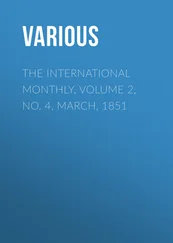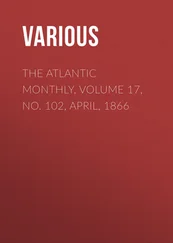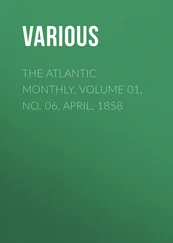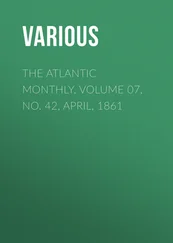Various - The International Monthly, Volume 3, No. 1, April, 1851
Здесь есть возможность читать онлайн «Various - The International Monthly, Volume 3, No. 1, April, 1851» — ознакомительный отрывок электронной книги совершенно бесплатно, а после прочтения отрывка купить полную версию. В некоторых случаях можно слушать аудио, скачать через торрент в формате fb2 и присутствует краткое содержание. Жанр: foreign_antique, periodic, foreign_edu, на английском языке. Описание произведения, (предисловие) а так же отзывы посетителей доступны на портале библиотеки ЛибКат.
- Название:The International Monthly, Volume 3, No. 1, April, 1851
- Автор:
- Жанр:
- Год:неизвестен
- ISBN:нет данных
- Рейтинг книги:3 / 5. Голосов: 1
-
Избранное:Добавить в избранное
- Отзывы:
-
Ваша оценка:
- 60
- 1
- 2
- 3
- 4
- 5
The International Monthly, Volume 3, No. 1, April, 1851: краткое содержание, описание и аннотация
Предлагаем к чтению аннотацию, описание, краткое содержание или предисловие (зависит от того, что написал сам автор книги «The International Monthly, Volume 3, No. 1, April, 1851»). Если вы не нашли необходимую информацию о книге — напишите в комментариях, мы постараемся отыскать её.
The International Monthly, Volume 3, No. 1, April, 1851 — читать онлайн ознакомительный отрывок
Ниже представлен текст книги, разбитый по страницам. Система сохранения места последней прочитанной страницы, позволяет с удобством читать онлайн бесплатно книгу «The International Monthly, Volume 3, No. 1, April, 1851», без необходимости каждый раз заново искать на чём Вы остановились. Поставьте закладку, и сможете в любой момент перейти на страницу, на которой закончили чтение.
Интервал:
Закладка:
This figure of Mr. Calhoun is considerably larger than that of the great senator. The face is represented with singular fidelity as it appeared ten years ago. The incongruous blending of the Roman toga with the palmetto must be borne: civilization is not sufficiently advanced for the historical to be much regarded in art; and our Washingtons, Hamiltons, Websters and Calhouns, must all, like Mr. Booth and Mr. Forrest, come before us in the character of Brutus. With this exception as to the design, every critic must admit the work to be faultless; and Charleston may well be proud of a monument to her legislator, which illustrates her taste while it reminds her of his purity, dignity, and watchful care of her interests.
By the wreck of the ship Elizabeth, the left arm of the statue was broken off, and the fragment has not been recovered.
2
The appearance of Whitehall from the Thames in the reign of Charles II. may be seen in our woodcut. The beautiful Banqueting-house of Inigo Jones was crowded among a heterogeneous mass of ugly buildings connected with the exigencies of the court. Beside the houses, to the spectator's left, was a large garden extending to the river, with fountains and parterres. A small garden also projected into the river in front of the buildings; and here Charles used to view the civic processions of the Lord Mayor, who on the day of his taking the oaths at Westminster, generally gratified the sovereign and other sight-seers with a pageant on the Thames, in some degree adulatory of the monarch. The king resided here so constantly, that the most striking pictures of his private manners are recorded to have happened at Whitehall, and for which the graphic pages of Pepys, Evelyn, and De Grammont may be consulted. Whitehall, indeed, has obtained its chief interest from its connection with the Stuarts. The Banqueting-house, erected by James I., in front of which his unfortunate son was executed; the residence of Cromwell here in a quietude, strangely contrasted with the voluptuousness of the Restoration; the flight of James II., and his queen's escape with her infant son by the water-gate, shown in our cut, closes the history of the Stuart family in this country of sovereigns; and the history also of the palace; for, on the 10th April, 1691, the greater part was burnt by a fire, which was succeeded by another in 1698, which destroyed nearly every building but the Banqueting-house, and Whitehall ceased to be the residence of royalty.
3
Nell's "town-house" was in Pall Mall. Pennant says, "it was the first good one on the left hand of St. James's Square, as we enter from Pall Mall. The back room on the second floor was (within memory) entirely of looking-glass, as was said to have been the ceiling. Over the chimney was her picture, and that of her sister was in a third room." At this house she died in 1691, and was pompously interred in the parish of St. Martin's-in-the-Fields, leaving that parish a handsome sum yearly, that every Thursday evening there should be six men employed for the space of one hour in ringing, for which they were to have a roasted shoulder of mutton and ten shillings for beer.
4
Pepys was Secretary to the Admiralty, and it was he who published, from the king's dictation, the minute and interesting account of his escape from the Battle of Worcester, and adventures a Boscobel, and in the "Royal Oak." He kept a very minute and amusing diary, in which he neglected not to enter the most trivial matters, even the purchase of a new wig, or a new riband for his wife. This very littleness of detail has made his Memoirs the most extraordinary picture we possess of the times. He appears to have been a coarse but shrewd man, and fully alive to the faults of his master.
5
Previous to the restoration of Charles II., the park of St. James's appears to have attracted little attention, and to have been left to the guidance of nature alone. Charles seems to have had Versailles in view when he laid it out from Le Notre's design. A long straight canal was formed in its centre from a square pond which existed at its foot near the Horse Guards. Rows of elm and lime trees were planted on each side of it, an aviary was formed in that place still called the "Bird Cage Walk;" and in the large space between this walk and the canal, and nearest the Abbey, an extensive decoy for wild fowl was constructed, popularly termed "Duck Island," and of which the famous St. Evremond was appointed a salaried governor. Charles, who was exceedingly fond of walking, and who tired out many a courtier who tried to keep up with his quick pace, was continually seen here amusing himself with the birds, playing with the dogs, or feeding the ducks. On the opposite side of the canal, three broad walks were constructed and shaded with trees, one for coaches, the other for walking, and the central one for the game of "Pall Mall," an athletic exercise of which the king and the gentlemen of the day were fond. The game consisted in driving a ball through a ring at the extremity of the walk, which had a narrow border of wood on each side of it to keep the ball within bounds. The floor of this portion of the park was made of mixed earth, covered with sea-sand and powdered shells as at Versailles. The park was much secluded, except on this side, which was that only accessible to the public in general. There, Spring Gardens, with its bowling-greens and gaming-tables, seduced the idle and dissipated, until the Mulberry Garden (which stood on the site of Carlton Gardens) put forth its attractions; and which, as Evelyn says, became "the only place of refreshment about the town for persons of the best quality to be exceedingly cheated at." The plays of the period abound with intrigue and adventure carried on at both places. The Mall ceased to be the resort of royalty at the death of Charles, but it continued to be the fashionable promenade until the close of the last century.
6
The house at Sandy End has been altered within the last few years. The characteristic gables of the roof, which so well marked its age, and display the taste of the period when it was constructed, are removed, and the house is so much modernized as to lose the greater part of its interest, and at first sight induce a doubt of its antiquity. The extensive gardens still remain, and some very old houses beside it, with a characteristic old wall bounding the King's road, inclosing some venerable walnut trees. Three years ago, a pretty view of these old houses, with Nell's in the back-ground, might have been obtained from the adjacent bridge over the brook: but now a large public house, "the Nell Gwynne," obstructs the view, a row of small "Nell Gwynne cottages" effectually block the path, and the primitive character of the scene has passed away for ever.
7
In the History of Costume in England, by the author of these notes, it has been remarked that the freedom and looseness, as well as ease and elegance of female costume at this period is to be attributed to the taste of Sir Peter Lely, rather than to that exhibited by the Beauties of Charles's court. "It was to his taste, as it was to that of a later artist, Sir Joshua Reynolds, that we are indebted for the freedom which characterized their treatment of the rigid and somewhat ungraceful costumes before them." Walpole, in his "Anecdotes of Painting," says, "Lely supplied the want of taste with clinquant ; his nymphs trail fringes, and embroidery, through meadows and purling streams. Vandyke's habits are those of the times; Lely's, a sort of fantastic night-gown fastened with a single pin." Lely's ladies are not unfrequently en masque , and are habited in the conventional dresses adopted for goddesses in the court of Versailles.
Читать дальшеИнтервал:
Закладка:
Похожие книги на «The International Monthly, Volume 3, No. 1, April, 1851»
Представляем Вашему вниманию похожие книги на «The International Monthly, Volume 3, No. 1, April, 1851» списком для выбора. Мы отобрали схожую по названию и смыслу литературу в надежде предоставить читателям больше вариантов отыскать новые, интересные, ещё непрочитанные произведения.
Обсуждение, отзывы о книге «The International Monthly, Volume 3, No. 1, April, 1851» и просто собственные мнения читателей. Оставьте ваши комментарии, напишите, что Вы думаете о произведении, его смысле или главных героях. Укажите что конкретно понравилось, а что нет, и почему Вы так считаете.












